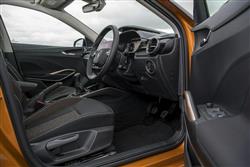AB FAB (some text hidden) --NONE--
By Jonathan Crouch
Skoda's fourth generation Fabia will appeal to sensibly-minded supermini folk. Jonathan Crouch drives it.
Ten Second Reviewword count: 46
Skoda's fourth generation Fabia makes up in sense and practicality for anything it might lack in dynamic looks and pin-sharp handling. All the latest VW Group chassis technology has finally made it to this supermini model line and the result is a very complete product indeed.
Backgroundword count: 192
Skoda's modern day renaissance can broadly be traced to one model, this one, the Fabia supermini. The design we look at here is the fourth generation Type PJ version, launched in 2021 and building on a heritage stretching back to 1999 when the MK1 Fabia arrived to replace the old-fashioned Felicia model. That all seems very long time ago now. Today, the Skoda brand is so in tune with the times that the Volkswagen Group has chosen it to develop its forthcoming range of small electric cars. But for the time being anyway, in the Czech maker's line-up, there still a place for a conventional combustion supermini like the Fabia. This MK4 version was the last of the VW Group superminis to get the brand's MQB-A0 chassis, a platform that by 2021 had already been in use in cars like Volkswagen's Polo, SEAT's Ibiza and Audi's A1 for half a generation. It was certainly needed for this Fabia, the previous car having been based on elderly PQ35 underpinnings dating all the way back to a turn-of-the-century MK5 Golf. It should make this fourth generation Fabia bigger. But has it made it better?
Driving Experienceword count: 210
Most Fabias are sold with the brand's 1.0-litre TSI petrol engine and Skoda has taken the opportunity of updating the more powerful version of it with a unit from the brand's EVO2 generation. That's increased power output from 110PS to 116PS; as before, a 6-speed manual gearbox comes as standard, with a 7-speed DSG auto optional. As before, the range also offers two more affordable 1.0-litre units; the older-spec 1.0 TSI unit in 95PS form (which can't be had with the auto option); and a normally aspirated MPI 1.0-litre engine with 80PS that's mated to a 5-speed manual gearbox and is offered for budget minded folk. We'd avoid it unless you particularly need the cheap insurance ratings that come with that engine. At the other end of the range, there's still a larger 1.5-litre TSI four-cylinder petrol unit with 150PS, paired non-negotiably with the DSG auto 'box. Expect solid rather than engaging roadgoing drive dynamics - in other words, tuned for comfort rather than engaging handling. Skoda has made the damping noticeably softer than, say, SEAT Ibiza and more like a Volkswagen Polo, which shares this Czech model's conventional torsion beam rear suspension set-up. There are no mild hybrid or plug-in powertrain options - they'd push the price too much.
To see the full road test text contact us on 0330 0020 227
Pictures (high res disabled)

.jpg)
|
.jpg)
|
.jpg)
| |||
.jpg)
|
.jpg)
|
.jpg)
| |||
.jpg)
|
.jpg)
|
.jpg)
| |||

|
Statistics (subset of data only)
Min |
Max |
|
Price: |
£19,880.00 (At 27 Sep 2024) |
£25,780.00 (At 27 Sep 2024) |
Insurance group 1-50: |
4 |
20 |
CO2 (g/km): |
122 (1.5 TSI) |
115 (1.0 TSI 95PS) |
Max Speed (mph): |
108 (1.0 MPI) |
137 (1.5 TSI) |
0-62 mph (s): |
15.7 (1.0 MPI) |
8 (1.5 TSI) |
Combined Mpg: |
52.1 (1.5 TSI) |
55.8 (1.0 TSI 95PS) |
Length (mm): |
4108 |
|
Width (mm): |
1780 |
|
Height (mm): |
1459 |
|
... and 2 other stats available | ||
Scoring (subset of scores)
Category: Small Runabouts
| Performance | |
| Handling | |
| Comfort | |
| Space | |
| Styling, Build, Value, Equipment, Depreciation, Handling, Insurance and Total scores are available with our full data feed. | |



